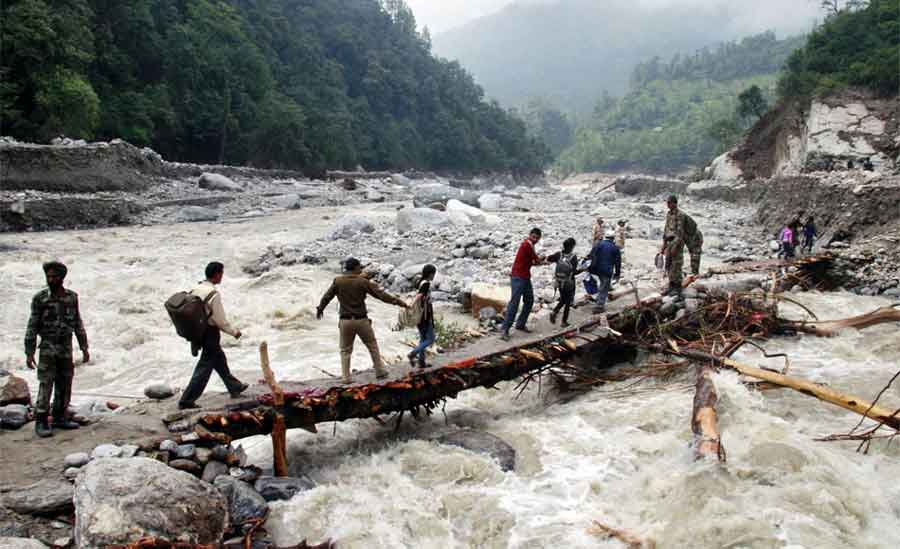 A nation is not only the territory, its natural resources or the amassed wealth but it is all about the great people that work towards making it a great entity. These people carry humanity in their hearts; they fight for the truth, strive for perfection and collectively face the challenges that present before the country. When a country is dared by a disaster, it faces a real litmus test. A great nation not only rises collectively to save the unfortunate and recover from the damage but also conveys to the world of its invincibility, even in the face of nature’s rage. The complexity involved in overcoming these trials and tests lies in Statesmanship at political level; leadership and unity at legislature level; foresight, forethought and organisational ability at executive level. All these factors contribute towards mobilising the people into selfless service towards the distressed and the devastated. The true character of a nation is thus reflected in the manner it deals with its disasters.
A nation is not only the territory, its natural resources or the amassed wealth but it is all about the great people that work towards making it a great entity. These people carry humanity in their hearts; they fight for the truth, strive for perfection and collectively face the challenges that present before the country. When a country is dared by a disaster, it faces a real litmus test. A great nation not only rises collectively to save the unfortunate and recover from the damage but also conveys to the world of its invincibility, even in the face of nature’s rage. The complexity involved in overcoming these trials and tests lies in Statesmanship at political level; leadership and unity at legislature level; foresight, forethought and organisational ability at executive level. All these factors contribute towards mobilising the people into selfless service towards the distressed and the devastated. The true character of a nation is thus reflected in the manner it deals with its disasters.
Whatever be the crisis and which ever be the force created to tackle such a challenge, it has finally been proved that there exists no better organisation in India other than its Armed Forces in living up to the expectations of our country men.
In the words of Chanakya “A calamity of a constituent, of a divine or human nature, springs from ill luck or wrong policy”. The nature wreaks havoc at the first place and the man by his misadministration adds to the devastation, in his words “Inversion of excellences, absence, a great defect, addiction or affliction constitutes a calamity”. Uttarakhand disaster has proved these sayings to be correct.
In our recent memory we can recollect some of the deadly disasters that India has faced in the past two decades. The disasters in form of earth quakes in 1991 at Tehri, 1993 at Latur and 2001 at Gujrat, super cyclone in 1991 that hit Orrisa, Tsunami in 2004, Kosi floods of 2008 in Bihar and the latest in the series being the Uttarakhand tragedy, all these account for more than a lakh deaths and more than 28 lakh people displaced. These catastrophes reaffirm, that 60 percent our country’s landmass is disaster prone. It was only after the Tsunami of 2004 that we decided to raise the NDMA (National Disaster Management Authority) having the responsibility of Preparedness, Rescue, Recovery and Mitigation. The NDRF battalions (National Disaster Response Force) were raised as a specialised force knitted and kitted to respond to both natural and manmade disasters.
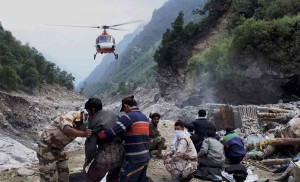 Whatever be the crisis and which ever be the force created to tackle such a challenge, it has finally been proved that there exists no better organisation in India other than its Armed Forces in living up to the expectations of our country men. On 26 Dec 2004 a deadly Tsunami struck the Eastern shores of Tamil Nadu, Andaman Nicobar Islands and other littoral countries in South East Asia, which left 3 lakh dead and another 6 lakh people displaced. The very same day Indian Navy deployed 19 ships and 11 helicopters, this commitment later rose to 32 naval ships, 7 aircrafts and 20 helicopters, conducting relief and rescue in Tamil Nadu, Andaman Nicobar islands, Sri Lanka, Maldives and Indonesia. The ability of the Indian nation to take a call and undertake disaster relief at such a large scale was noticed by the Asian and Western powers and thus we re-established our credentials as a major regional power. The political strength, military robustness and its operational readiness were displayed during this crisis. Our country appeared confident with the economy growing at 9 per cent and a strong military to support it, not only capable of handling crisis situation within but also rendering help in the neighbourhood.
Whatever be the crisis and which ever be the force created to tackle such a challenge, it has finally been proved that there exists no better organisation in India other than its Armed Forces in living up to the expectations of our country men. On 26 Dec 2004 a deadly Tsunami struck the Eastern shores of Tamil Nadu, Andaman Nicobar Islands and other littoral countries in South East Asia, which left 3 lakh dead and another 6 lakh people displaced. The very same day Indian Navy deployed 19 ships and 11 helicopters, this commitment later rose to 32 naval ships, 7 aircrafts and 20 helicopters, conducting relief and rescue in Tamil Nadu, Andaman Nicobar islands, Sri Lanka, Maldives and Indonesia. The ability of the Indian nation to take a call and undertake disaster relief at such a large scale was noticed by the Asian and Western powers and thus we re-established our credentials as a major regional power. The political strength, military robustness and its operational readiness were displayed during this crisis. Our country appeared confident with the economy growing at 9 per cent and a strong military to support it, not only capable of handling crisis situation within but also rendering help in the neighbourhood.
It clearly emerged that Pakistan was a state surviving on the Western ventilator, having a state within a state, run by the religious fundamentalist which not only threatened the region but the world peace at large.
Before analysing the disaster management and our response in Uttarakhand it would be prudent to run a regional scan covering disasters especially in our neighbourhood. China has recently witnessed two major disasters, first the earth quake of 2008 and later the floods of 2010 and Pakistan had to deal with the earthquake of 2005.
In China an earth quake hit South Western Sichuan province that killed 2,40,000 people. The Chinese mobilised 1,30,000 troops to carry out relief and rescue effort. The world saw this effort and analysed the performance of Chinese military. Though the PLA was mobilised immediately, however it took 72 hours to save the first life. The fastest growing economy in the world, having strong central leadership soon realised the deficiencies of the military and undertook measures to overcome them. The strength of this nation was visible during the world’s largest evacuation led by the PLA evacuating 8,00,000 people during the floods of 2010 and subsequent quick recovery.
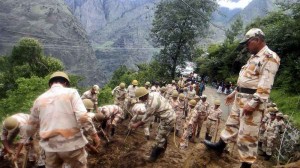 In the year 2005 an earth quake hit the Pakistan Occupied Kashmir (POK) killing over 75,000 people. Aid poured from all over the world which was well over 5.4 billion US dollars and this country was assisted by the US military and the British army helicopters stationed in Afghanistan in relief and rescue efforts. What was unusual, disturbing and alarming to the regional security was the inclusion of the Jihadi groups in the relief efforts. Out of the known 24 militant organisations, Lashkar-e- Toiba and Jaish-e-Mohamad took a lead role in carrying out the relief and rescue, thus they virtually established themselves parallel to the state. It clearly emerged that Pakistan was a state surviving on the Western ventilator, having a state within a state, run by the religious fundamentalist which not only threatened the region but the world peace at large.
In the year 2005 an earth quake hit the Pakistan Occupied Kashmir (POK) killing over 75,000 people. Aid poured from all over the world which was well over 5.4 billion US dollars and this country was assisted by the US military and the British army helicopters stationed in Afghanistan in relief and rescue efforts. What was unusual, disturbing and alarming to the regional security was the inclusion of the Jihadi groups in the relief efforts. Out of the known 24 militant organisations, Lashkar-e- Toiba and Jaish-e-Mohamad took a lead role in carrying out the relief and rescue, thus they virtually established themselves parallel to the state. It clearly emerged that Pakistan was a state surviving on the Western ventilator, having a state within a state, run by the religious fundamentalist which not only threatened the region but the world peace at large.
It would not be incorrect to say that this new setup called the NDMA has failed our nation; it is probably yet another bureaucratic organisation that we are suffering with.
Now focusing on the Uttarakhand disaster and the Indian response, it is essential that we draw a conclusion of our strengths and the deficiencies, before suggesting remedial measures. Post Tsunami of 2004, NDMA was created under the noble thought of creating a structure which would make our country better prepared, with all the necessary tools and instruments available at the time of crisis. It would not be incorrect to say that this new setup called the NDMA has failed our nation; it is probably yet another bureaucratic organisation that we are suffering with. Some facts need to be placed before any worthwhile deductions are drawn, and they are as follows:
- Total population of Uttarakhand is 1 crore and nearly 2.5 crore tourists visit the hill state annually.
- During the month of June, at any given point and time there are more than 1 lakh tourists / pilgrims on the Haridwar – Rishikesh – kedarnath / Badrinath axis.
- Himalayan mountain ranges are the youngest mountains in the world and hence susceptible to slightest of ecological disturbances.
- This region is highly prone to earthquakes, floods and landslides.
- Jammu, Himachal and Uttarakhand incidentally have the highest density of ex-servicemen, a readily available pool of trained man power.
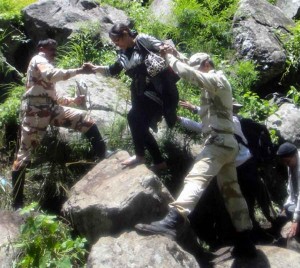 The Uttarakhand crisis has brought forth the lack of statesmanship both at the centre and the state level. Our political leaders representing the legislature failed miserably, since their focus was more towards garnering brownie points and exploiting photo opportunity displaying utter disregard to the national sentiments. The state government and the administration turned a blind eye to rampant destruction of ecology in the name of development. The NDMA failed to map the disaster prone areas of the country and also proved inadequate in monitoring the functioning of the State Disaster Management Authority. This disaster has proved the incompetence of the government’s machinery in analysing and displaying a foresight and fore thought in tackling such a crisis.
The Uttarakhand crisis has brought forth the lack of statesmanship both at the centre and the state level. Our political leaders representing the legislature failed miserably, since their focus was more towards garnering brownie points and exploiting photo opportunity displaying utter disregard to the national sentiments. The state government and the administration turned a blind eye to rampant destruction of ecology in the name of development. The NDMA failed to map the disaster prone areas of the country and also proved inadequate in monitoring the functioning of the State Disaster Management Authority. This disaster has proved the incompetence of the government’s machinery in analysing and displaying a foresight and fore thought in tackling such a crisis.
Had the vast ex-servicemen population, tapped by the government in creating a potent disaster relief force, which would come really handy to the state in this crisis, many lives could have been saved.
A large number of human lives could have been saved if the administration had created disaster shelters at different places, controlled the unchecked flow of tourists/pilgrims and ensured encroachment free river beds, shown sensitivity towards ecology and respected the mountains. Had the vast ex-servicemen population, tapped by the government in creating a potent disaster relief force, which would come really handy to the state in this crisis, many lives could have been saved. The lowest form of human nature was witnessed during this sad period. The goons looted the beleaguered pilgrims; there were wide spread reports of rape and larceny, even the dead bodies were not spared. Over politicised Indian society, rampant institutionalised corruption over a prolonged period of six decades is probably the result of this decay.
The callousness of our leadership was responsible for delayed requisitioning of the army, had a timely decision been taken, many homes would have been saved from agony and irrecoverable losses. The time tested Indian Armed Forces proved their worth once again; they carried out one of the largest rescue operation ever in such inhospitable terrain. The devastated 40,000 sq km of Uttarakhand were addressed by 10,000 troops of Indian Army supported by over 50 aircrafts and helicopters of the Indian Air Force, these dedicated men and women helped the evacuation of up to 80,000 people. Today the armed forces stand tall in the eyes of the countrymen. This is not only shameful for the civil administration but also a subject of mockery in a democratic society.
Whatever be the reason, the world has witnessed poor and shoddy preparedness and response of the Indian nation in this crisis. The regional leadership of India SE Asia today stands questioned, shameless record breaking scams, dwindling economy, fractured polity, week and feeble administration, invisible leadership are some of the factors that may lead to such a conclusion. This drought of leadership and statesmanship has manifested in a number of cases, be it the response after beheading of Indian troops on the LOC or our response to the Chinese intrusion in Ladhak. Same is the story when it comes to a response to the Naxal threat or the general law and order issue prevailing in the country.
To regain the respectability in the international environment and simultaneously restore confidence of the state in its public, India needs to strengthen various response mechanisms and bring into play hard core professionals to head the organisation like the NDMA rather than create bureaucratic institutions one after the other. Long awaited political and administrative reforms need to be implemented or else we will continue to suffer crisis after crisis.




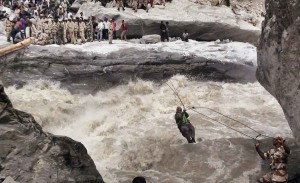

All because of bad administration , preparedness and policies.
Disaster follows when country is ruled by cahrecterless pigmies ruling over helpless masses.
The ranks of the armed forces have shown professionalism once again.
The civilian administration ,the IAS did not do their homework for disaster management nor do they have any clue on post trauma strategy also.
The work carried out by the ranks now should be furthered by genralmanship .
It is the right time for the highest echelon of the tri services to come into play. They should not feel shy of stating clearly to the nation that the Armed Forces have once again cleaned up the mess created by the IAS in a civilian tragedy which was supposed to be tackled by civilian administration.
Thus the army should take the opportunity ask the nation and convey to the IAS which has failed on all counts that it should not be in a position to dictate terms to the army whilst dealing in military affairs be it modernization requirements or in case of wars like kargil , or in dealing with situations like in Kashmir.
This is also a golden opportunity to tell the govt and the IAS to comply IMMEDIATELY with the Supreme court’s decision on OROP and veteran’s dues. At this juncture the nation acknowledges the work done by the ranks of the armed forces and many like me are waiting for the voices of the admirals, generals and the air marshals sitting in N Delhi to stand by the ranks…not be just writing letters but by striking hard, striking first when the iron is hot…address the nation sirs ..please
The nation remembers chiefs like those who segmented/broke the air force into categories vis a vis, fighters/helicopters/engineers and nearly started a segment based on the above vis a vis pay…but then the nation also remembers True Generals Like Thimaya….choice where one wants to be remembered by has to be made..silence and pussyfooting automatically accounts for decision made…
natural disasters will continue to strike and cause mammoth destruction; that is why they are called DISASTERS! Preparation and response mechanism to such calamities is what has been covered in this article including some innovative ideas. But what has been left out in the coverage is MITIGATION. our response to the deluge after the immediate actions is what is going to demonstrate our fighting spirit IF , like we normally do, do not quickly erase this from our memory. Reconstruction / rehab/ planning and implementing in place of what has been lost in a BETTER manner is the requirement of the day. Can we do it ?
The author has brought out the bare truth in his article. We all know the consistency of failure of civil administration in times of crisis since independence. But what has been missed is its failure in delivering even in normal times & situations. Unless the civil administration increases its efficiency in normal times , it will never be able to deliver in crisis. The Armed Forces are able to deliver every time in times of crisis irrespective of the situation, because they try to achieve perfection and deliver with high efficiency even in day today situations. However, unless they are given their due by the administration, it will be difficult for them to rise to the occasion in times of crisis. The case of One rank one pension & the fight by the Services to get the arrears of Pay Commission pending since 1986 through the court r frustrating & demoralising. & such situations must be avoided. However, at this juncture, our sympathies r with the people of Uttarakhand & thousands of tourists who have been affected by these devastating floods. Well done. Good job done by the author in bringing out the truth
sir… tis article indeed gives the reader a thorough insight of the op saayata and the systems/agencies in place .